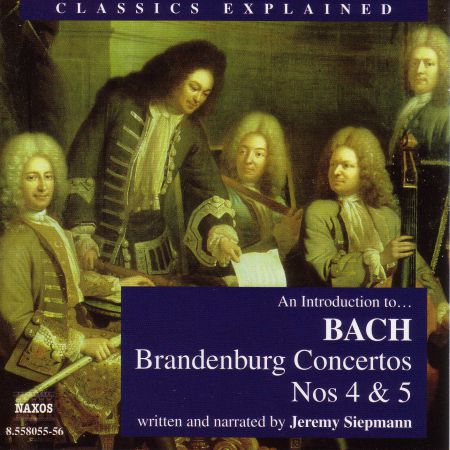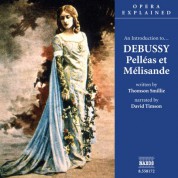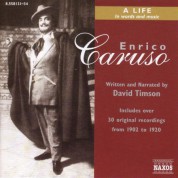Classics Explained: Bach, J.S. - Brandenburg Concertos Nos 4 & 5 (Siepmann) - CD
Tükendi
Bu Ürün Stoklarımıza Girince Haberdar Olmak İster Misiniz?
(+) Stoklara Girince Haber Ver
(+) Stoklara Girince Haber Ver
Ürün Hakkında
Barkod: 0636943805527
, Katalog No: 8.558055-56 , Firma: Naxos
, Seri: Naxos Classics Explained
, Yayınlanma Tarihi:
26 Temmuz 2002
Format Türü: CD, Format: 2 CD
Eser Listesi
- CD - 1
- Brandenburg Concerto No. 4 in G
- 1. The Brandenburgs as concerti grossi
- 00:01:28

- Brandenburg Concerto No. 4 in G - First Movement
- 2. Introduction: Melody, Theme and Motif; Bach's opening gambit
- 00:02:15

- 3. Onwards and upwards: Motif No. 2 and its function
- 00:00:51

- 4. The two elements of Motif No. 2 and the effect of their combination
- 00:00:28

- 5. The 'motto' rhythm hidden even within the opening bar
- 00:01:07

- 6. Motif No. 3, introduced by the two recorders, has a kind of 'hovering' character
- 00:00:26

- 7. Motif No. 3 repeated for a second, 'directed' listen
- 00:00:23

- 8. Bach reminds us of the opening
- 00:00:17

- 9. Motif No. 4 - a steadily rising derivative of Motif No. 1
- 00:00:19

- 10. Motif No. 5, a lovely, bouncy, syncopated flourish, in which all the instruments join
- 00:00:23

- 11. Opening Ritornello (complete)
- 00:01:47

- 12. Episode 1 begins with virtuoso entry of the solo violin, made up of alternating arpeggios
- 00:01:15

- 13. Motif No. 3 returns, courtesy of the recorders, recently sidelined by the violin
- 00:00:47

- 14. Ritornello 2, a varied repeat of Ritornello 1, arrives after much harmonic movement
- 00:00:43

- 15. Episode 2, Part 1, preceded by the 'fanfare' motif from which its first theme derives
- 00:00:59

- 16. Episode 2 continued, with more bravura dazzle from the solo violin
- 00:01:05

- 17. Repeat of section for purposes of hearing the harmonic movement
- 00:00:47

- 18. Ritornello 3, with the prominent participation of the soloists
- 00:00:47

- 19. Episode 3 proves retrospective, featuring transposed repeats of earlier material
- 00:00:49

- 20. Ritornello 4, not altogether what it might seem; solo violin takes 'motto' motif
- 00:00:48

- 21. Episode 4. Cue to Part 1, focusing on 'soloistic' counterpoint provided by the continuo
- 00:00:56

- 22. Return to Ritornello 4 to hear sources of Episode 4, Part 2
- 00:00:36

- 23. Episode 4 continued, with emphasis placed on conversational interchanges
- 00:00:28

- 24. Return to opening Ritornello in order to enhance awareness of the contrast
- 00:00:53

- 25. Ritornello 5, beginning
- 00:00:10

- 26. Ritornello 5 continued, with emphasis on the determined banishment of B Minor
- 00:00:56

- 27. Cue to complete performance of First Movement
- 00:00:46

- 28. First Movement (complete)
- 00:06:19

- Brandenburg Concerto No. 4 in G - Second Movement
- 29. Introduction: Rhythmic Motif provides basis for whole movement
- 00:01:17

- 30. The melody not much to write home about; nor is the meek 'answer' offered by the soloists
- 00:00:14

- 31. Putting the two together, thereby establishing a relationship
- 00:00:21

- 32. Contrast and syncopation - their relationship in opening section
- 00:02:18

- 33. Listening from the 'botton up'
- 00:02:48

- 34. The intertwining and alternation of solo and orchestra; the irregularity of metrical groupings
- 00:02:14

- 35. The next orchestral phrase; slowing the pace but not the tempo
- 00:00:28

- 36. The First Section (complete)
- 00:01:36

- 37. The next section; foreground symmetry and background variety
- 00:01:29

- 38. The central section's groupings are hugely asymmetrical
- 00:01:12

- 39. Cue to Second Movement as a whole
- 00:00:11

- 40. Second Movement (complete)
- 00:03:17

- Brandenburg Concerto No. 4 in G - Third Movement
- 41. Introduction to the Third Movement...
- 00:04:57

- 42. Fugue subject
- 00:01:04

- 43. First counter-subject
- 00:00:31

- 44. Second counter-subject
- 00:00:51

- 45. Bass entry of the subject
- 00:00:14

- 46. Exposition (complete)
- 00:00:33

- 47. First Episode; the use of fragmentary derivatives
- 00:00:33

- 48. The difference a detail can make!
- 00:00:15

- 49. Harmonic Rhythm defined; back to the beginning to find the seed...
- 00:01:06

- 50. ...and now the blossom
- 00:00:21

- 51. The First Solo Episode; a confusion of terms; onwards, to the introduction of the solo episode
- 00:01:59

- 52. Ritornello 2 complete
- 00:01:11

- 53. Solo Episode 2 dominated by thrilling virtuosity from the solo violin
- 00:01:47

- 54. Ritornello 3: highly contrapuntal and dominated by subject-derivatives, with much harmonic fluidity
- 00:00:46

- 55. Ritornello 3 continues: engine of harmonic motion repeated at higher pitch
- 00:00:06

- 56. More on Ritornello 3: the use of long, sustained, slightly syncopated notes in upper strings
- 00:00:21

- 57. Ritornello 3 (complete)
- 00:00:31

- 58. Solo Episode 3 - less solo than earlier ones, what with (albeit very discreet)
- 00:00:28

- 59. The two recorders converse in canon, accompanied for six exhilarating bars by cello 'continuo'
- 00:00:22

- 60. Finishing Solo Exposition 3: orchestral cellos introduce what sounds
- 00:00:33

- 61. Approaching the final Ritornello; stretto explained
- 00:00:56

- 62. Cue to Finale Ritornello, noting tension-building 'pedal point' in cellos and double bass
- 00:01:02

- 63. Coda - the 'tail-piece', with its surprising 'hammer strokes'
- 00:00:58

- 64. Cue to Third Movement
- 00:00:19

- 65. Third Movement (complete)
- 00:04:31

- CD - 2
- Brandenburg Concerto No. 5 in D - First Movement
- 1. Opening Music; analysis and phony analysis; Shaw quote; music: Motif No. 1
- 00:03:07

- 2. Music, energy and relationship
- 00:00:58

- 3. The outlines of a melody emerge
- 00:00:41

- 4. The opening bar again
- 00:00:25

- 5. Motif No. 2: ta / dee-ya, dee-ya, dee-ya
- 00:00:11

- 6. Motif No. 3, and an important feature of its rhythm
- 00:00:32

- 7. Beethoven Fifth Symphony (opening)
- 00:00:19

- 8. Motif No. 4
- 00:00:12

- 9. Motif No. 5
- 00:00:04

- 10. Motif No. 6
- 00:00:05

- 11. Episode 1: a 'Love Duet'
- 00:01:39

- 12. Episode 1 continued; violin and flute reverse direction of their theme
- 00:01:01

- 13. 'False' Ritornello; soloists interrupt; rising 'sighing' motif; harpsichord continues downwards
- 00:00:59

- 14. Four things going on at once, in violin, flute, harpsichord right hand, harpsichord left hand
- 00:00:39

- 15. The orchestra returns, picking up at exactly the spot where it was interrupted
- 00:00:28

- 16. The harpsichord intervenes with derivative of Motif 4; key shifts from A Major to B Minor
- 00:00:25

- 17. The orchestra returns to foreground and brings this section to an end
- 00:00:41

- 18. Harpsichord emerges as virtuoso; a series of expectations are frustrated
- 00:02:32

- 19. A backwards look; blurred distinctions between soloists and orchestra; 'Mozartian' development
- 00:04:35

- 20. Out of the Twilight Zone; a sequence of surprises
- 00:01:57

- 21. The epoch-making harpsichord cadenza and the final Ritornello
- 00:04:50

- 22. Cue to First Movement
- 00:00:52

- 23. First Movement (complete)
- 00:08:59

- Brandenburg Concerto No. 5 in D - Second Movement
- 24. Introduction; the opening Ritornello
- 00:02:33

- 25. The first bar; the first main building block
- 00:00:16

- 26. The flute motif
- 00:00:16

- 27. Opening of the first solo episode
- 00:01:04

- 28. An important motif; the second main building block
- 00:00:17

- 29. The second main theme
- 00:00:32

- 30. Ritornello 2; violin and flute as 'orchestra'
- 00:00:52

- 31. Episode 2; inversion of original motifs
- 00:00:38

- 32. More on Episode 2
- 00:00:10

- 33. Episode 1 and Episode 2 compared
- 00:00:21

- 34. Episode 2; key shifts from D Major to F-Sharp Minor
- 00:00:49

- 35. Ritornello 3: an exact transposition of Ritornello 1
- 00:00:46

- 36. Episode 3 contrasted with Episode 1
- 00:00:33

- 37. Episode 3 described in detail
- 00:01:05

- 38. Ritornello 4; second main theme's first appearance in a Ritornello
- 00:00:57

- 39. Episode 4: dominated by inversions
- 00:01:34

- 40. Cue to Second Movement
- 00:00:06

- 41. Second Movement (complete)
- 00:05:39

- Brandenburg Concerto No. 5 in D - Third Movement
- 42. Introduction: Ritornello 1
- 00:00:54

- 43. The Fugue Subject: close juxtaposition of contrasting elements
- 00:01:21

- 44. Flute takes the 'answer', with countersubject in the violin
- 00:00:33

- 45. Contrary motion as a contrapuntal device
- 00:00:23

- 46. Contrary motion as a listening aid; a new theme
- 00:00:31

- 47. Playing with the counter-subject; a musical game of tag
- 00:00:51

- 48. Hidden rhythms: background variety behind foreground uniformity
- 00:00:43

- 49. Fugal writing and the compatibility of parts; the Exposition
- 00:01:35

- 50. Episode 1, taken by soloists, contains important 'seeds'
- 00:00:37

- 51. The orchestra enters at last, but by stealth
- 00:01:19

- 52. Stretto and musical football
- 00:01:02

- 53. Key changes to B Minor, introducing extensive Middle Section
- 00:01:24

- 54. The Middle Section a precursor of the Mozartian 'development'
- 00:03:05

- 55. The Fugue Subject out in force: first four immediately consecutive entries yet
- 00:01:51

- 56. Ambiguity of mode and a Scottish twist
- 00:00:38

- 57. Middle Section sontinued; harpsichord dominates
- 00:02:10

- 58. Cue to Last Movement
- 00:00:19

- 59. Last Movement (complete)
- 00:04:55

Katkıda Bulunanlar
|
Bu Ürünler İlginizi Çekebilir











